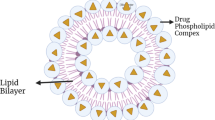Abstract
Traditionally, herbal medicine is consumed by drinking decoctions produced by boiling herbs with water. The functional components of the decoction are heat stable. Small RNAs (sRNAs) were reported as a new class of functional components in decoctions. However, the mechanisms by which sRNAs survive heat treatment of the decoction and enter cells are unclear. Previous studies showed that plant-derived exosome-like nanoparticles (ELNs), which we call botanosomes, could deliver therapeutic reagents in vivo. Here, we report that heat-stable decoctosomes (ELNs) from decoctions have more therapeutic effects than the decoctions in vitro and demonstrate therapeutic efficacy in vivo. Furthermore, sRNAs, such as HJT-sRNA-m7 and PGY-sRNA-6, in the decoctosome exhibit potent anti-fibrosis and anti-inflammatory effects, respectively. Decoctosome is comprised of lipids, chemical compounds, proteins, and sRNAs. A medical decoctosome mimic is called bencaosome. A single lipid sphinganine (d22:0) identified in the decoctosome was mixed and heated with the synthesized sRNAs to form the simplest bencaosome. This simple bencaosome structure was identified by critical micelle concentration (cmc) assay that sRNAs coassembled with sphinganine (d22:0) to form the lipid layers of vesicles. The heating process facilitates co-assembly of sRNAs and sphinganine (d22:0) until a steady state is reached. The artificially produced sphinganine-HJT-sRNA-m7 and sphinganine- PGY-sRNA-6 bencaosomes could ameliorate bleomycin-induced lung fibrosis and poly(I:C)-induced lung inflammation, respectively, following oral administration in mice. Our study not only demonstrates that the herbal decoctosome may represent a combinatory remedy in precision medicine but also provides an effective oral delivery route for nucleic acid therapy.
Similar content being viewed by others
Change history
08 July 2020
Following the published article, we noticed an error duplication in Figure 5G ���control��� and ���PGY-6��� that was introduced during the revised process, with an attempt to replace it with higher-resolution images. Here we provide the original data in the first submitted manuscript (Figure 5G):
References
Barile, L., and Vassalli, G. (2017). Exosomes: Therapy delivery tools and biomarkers of diseases. Pharmacol Therapeutics 174, 63–78.
Bligh, E.G., and Dyer, W.J. (1959). A rapid method of total lipid extraction and purification. Can J Biochem Physiol 37, 911–917.
Chen, X., Zen, K., and Zhang, C.Y. (2013). Reply to Lack of detectable oral bioavailability of plant microRNAs after feeding in mice. Nat Biotechnol 31, 967–969.
Dickinson, B., Zhang, Y., Petrick, J.S., Heck, G., Ivashuta, S., and Marshall, W.S. (2013). Lack of detectable oral bioavailability of plant microRNAs after feeding in mice. Nat Biotechnol 31, 965–967.
Du, J., Liang, Z., Xu, J., Zhao, Y., Li, X., Zhang, Y., Zhao, D., Chen, R., Liu, Y., Joshi, T., et al. (2017). Plant-derived phosphocholine facilitates cellular uptake of anti-pulmonary fibrotic HJT-sRNA-m7. Sci China Life Sci 15.
Huang, F., Du, J., Liang, Z., Xu, Z., Xu, J., Zhao, Y., Lin, Y., Mei, S., He, Q., Zhu, J., et al. (2018). Large-scale analysis of small RNAs derived from traditional Chinese herbs in human tissues. Sci China Life Sci 431.
Kalluri, R. (2016). The biology and function of exosomes in cancer. J Clin Invest 126, 1208–1215.
Lai, R.C., Yeo, R.W.Y., Tan, K.H., and Lim, S.K. (2013). Exosomes for drug delivery—a novel application for the mesenchymal stem cell. Biotech Adv 31, 543–551.
Li, X.W., Chen, H.P., He, Y.Y., Chen, W.L., Chen, J.W., Gao, L., Hu, H.Y., and Wang, J. (2018). Effects of rich-polyphenols extract of Dendrobium loddigesii on anti-diabetic, anti-inflammatory, anti-oxidant, and gut microbiota modulation in db/db mice. Molecules 23, 3245.
Li, Z., Wang, H., Yin, H., Bennett, C., Zhang, H.G., and Guo, P. (2018). Arrowtail RNA for ligand display on ginger exosome-like nanovesicles to systemic deliver siRNA for cancer suppression. Sci Rep 8, 14644.
Senturk, A., and Tekinsoy Kartin, P. (2018). The effect of lavender oil application via inhalation pathway on hemodialysis patientsʼ anxiety level and sleep quality. Holistic Nursing Practice 32, 324–335.
Théry, C., Amigorena, S., Raposo, G., and Clayton, A. (2006). Isolation and characterization of exosomes from cell culture supernatants and biological fluids. Curr Prot Cell Biol 30, 3.22.1–3.22.29.
Wang, J.H., Nie, H.L., Tam, S.C., Huang, H., and Zheng, Y.T. (2002). Anti-HIV-1 property of trichosanthin correlates with its ribosome inactivating activity. FEBS Lett 531, 295–298.
Wang, Q., Zhuang, X., Mu, J., Deng, Z.B., Jiang, H., Zhang, L., **ang, X., Wang, B., Yan, J., Miller, D., et al. (2013). Delivery of therapeutic agents by nanoparticles made of grapefruit-derived lipids. Nat Commun 4, 1867.
Yang, N., Dong, Z., Tian, G., Zhu, M., Li, C., Bu, W., Chen, J., Hou, X., Liu, Y., Wang, G., et al. (2016). Protective effects of organic acid component from Taraxacum mongolicum Hand.-Mazz. against LPSinduced inflammation: Regulating the TLR4/IKK/NF-κB signal pathway. J Ethnopharmacol 194, 395–402.
Zhuang, X., Teng, Y., Samykutty, A., Mu, J., Deng, Z., Zhang, L., Cao, P., Rong, Y., Yan, J., Miller, D., et al. (2016). Grapefruit-derived nanovectors delivering therapeutic miR17 through an intranasal route inhibit brain tumor progression. Mol Ther 24, 96–105.
Acknowledgements
This work was supported by the National Natural Science Foundation of China (81788101), the Ministry of Science and Technology of China (2015CB553406), the National Natural Science Foundation of China (81490531) and the CAMS Innovation Fund for Medical Sciences (2017-I2M-1-009).
Author information
Authors and Affiliations
Corresponding authors
Electronic supplementary material
Rights and permissions
About this article
Cite this article
Li, X., Liang, Z., Du, J. et al. Herbal decoctosome is a novel form of medicine. Sci. China Life Sci. 62, 333–348 (2019). https://doi.org/10.1007/s11427-018-9508-0
Received:
Accepted:
Published:
Issue Date:
DOI: https://doi.org/10.1007/s11427-018-9508-0




